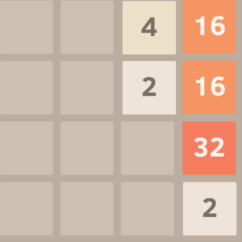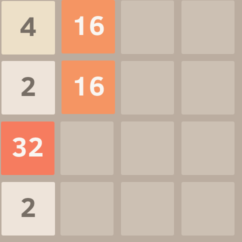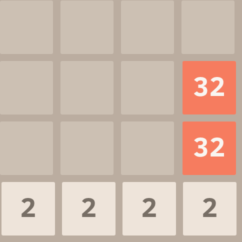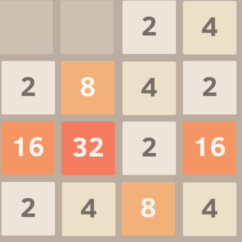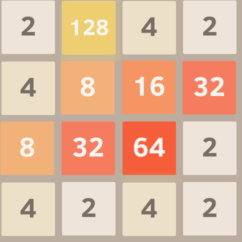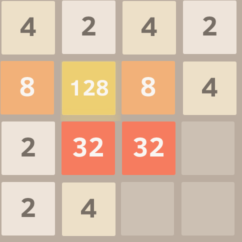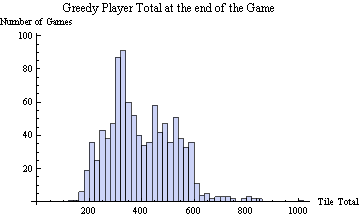A guy named Phil asked me to post my code, so here it is. It’s in Mathematica, so I imagine that most people will have trouble reading it. I will probably rewrite the code in a more common, faster language later.
(* Mathematica code for simulating 2048
- by Hein Hundal (Public Domain)
Visit http://gabrielecirulli.github.io/2048/
for more detials.
*)
(* collapse[v] takes a list of values and returns a
collapsed list of values where two consecutive equal
values are summed into one value. *)
collapse[v_List] := PadRight[
collapseAux[Cases[v, _Integer]] , 4, "."];
collapseAux[{}] = {};
collapseAux[{x_}] = {x};
collapseAux[v_List] := If[ v[[1]] == v[[2]],
Prepend[ collapseAux[Drop[v, 2]], v[[1]]*2],
Prepend[ collapseAux[Drop[v, 1]], v[[1]]]];
vGlobalMoves = Characters["lrud"];
mGlobalEmptyBoard = Table[".", {4}, {4}];
move[mBoard_, sMove_String] := Switch[sMove,
"l", collapse /@ mBoard,
"r", Reverse /@ collapse /@ Reverse /@ mBoard,
"u", Transpose[ collapse /@ Transpose[ mBoard ]],
"d", Reverse[ Transpose[
collapse /@ Transpose[ Reverse[ mBoard]]]],
_, Throw[{"move::illeagal move", sMove}]];
(* game1Turn[ mStart_List, randFunc_, moveStrat_]
Performs one turn of the game.
- mStart is a 4 x4 game matrix where every elemet
is either a number 2, 4, 8, ... or the string ".".
- randFunc is any function that take a positive
integer n as input and outputs a positive integer
between 1 and n.
- moveStrat is any function that takes a game board as
an input and gives as an output one of the four
characters u, d, l, r.
- The output of game1Turn is a new board state. *)
game1Turn[ mStart_List, randFunc_, moveStrat_] :=
Module[{sMove, mBoard, mEmpty, iSpot, iVal},
sMove = moveStrat[mStart];
mBoard = move[mStart, sMove];
(* only add a new piece if the board changed *)
If[ mBoard =!= mStart,
mEmpty = Position[mBoard, "."];
iSpot = randFunc[Length[mEmpty]];
(* the new board tile will either be a 4 or a 2 *)
iVal = If[ randFunc[10] == 1, 4, 2];
mBoard = ReplacePart[mBoard, mEmpty[[iSpot]] -> iVal]
];
mBoard];
(* gameManyTurns - executes iDo turns of the game *)
gameManyTurns[mStart_List, randFunc_, moveStrat_, iDo_Integer] :=
NestList[game1Turn[#, randFunc, moveStrat] &, mStart, iDo];
(******************* Display Results of Multiple Runs **********)
periodTo0[m_List] := m /. "." -> 0;
maxTile[m_List] := Max[Flatten[periodTo0[m]]]
totalTiles[m_List] := Total[Flatten[periodTo0[ m ]]];
rand1[i_Integer] := 1 + RandomInteger[i - 1];
(* rand2[m] replaces a random entry on the board m with a 2 *)
rand2[m_List] := ReplacePart[ m,
(RandomInteger[3, {2}] + 1) -> 2];
runSeveralGames[ randFunc_, moveStrat_, iDo_Integer] :=
Module[{},
Table[
(* run a single game for 100 turns *)
ten1 = gameManyTurns[rand2[mGlobalEmptyBoard],
randFunc, moveStrat, 100];
(* keep going until there is not change for 50 moves *)
While[ ten1[[-50]] =!= ten1[[-1]] && Length[ten1] < 10000,
ten1 = Join[ten1, gameManyTurns[ten1[[-1]],
randFunc, moveStrat, 100]]
];
ten2 = TakeWhile[ ten1, # =!= ten1[[-1]] &];
(* output a list {# turns of the game, tile Total,
maximum tile} for each game *)
{Length[ten2], totalTiles[Last[ten1]], maxTile[ten1[[-1]]]},
{iDo}]];
stats[mRes_List] := Module[{mRN = N@mRes},
{Mean[mRN], StandardDeviation[mRN], Max[mRes[[All, 3]]],
Tally[mRes[[All, 3]]] // Sort}];
(******** Blind Cyclic Strategy ****************************)
(* createCyclicStrategy - creates a cyclic strategy function
from the string s. If s = "uddl", then the strategy function
will repeat the sequence move up, move down, move down, and
move left indefinitely. *)
createCyclicStrategy[sMoves_String] := Module[
{exHeld, iCount = 1},
exHeld = Hold[
Function[ m, chars[[ Mod[iCount++, iStringLength] + 1]]]];
ReleaseHold[
exHeld /. {chars -> Characters[sMoves] ,
iStringLength -> StringLength[sMoves]}]];
testOneStrategy[] := Module[{},
stratDRDL = createCyclicStrategy["drdl"];
mRes = runSeveralGames[rand1, stratDRDL, 100];
stats[mRes]];

